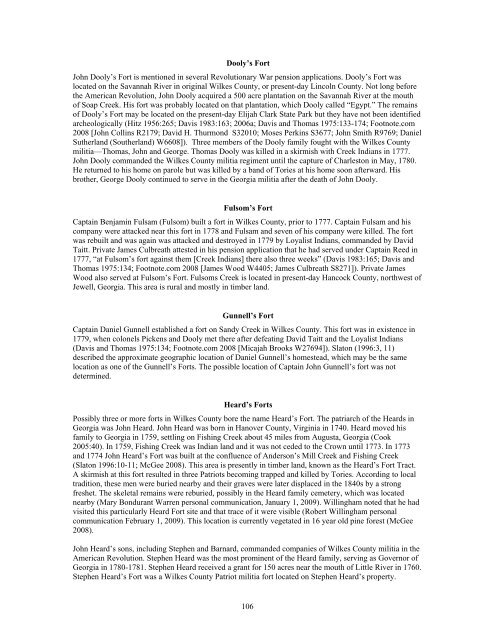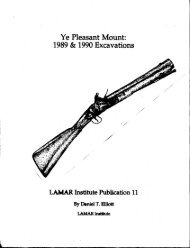Stirring Up a Hornet's Nest: - UGA Laboratory of Archaeology ...
Stirring Up a Hornet's Nest: - UGA Laboratory of Archaeology ...
Stirring Up a Hornet's Nest: - UGA Laboratory of Archaeology ...
You also want an ePaper? Increase the reach of your titles
YUMPU automatically turns print PDFs into web optimized ePapers that Google loves.
Dooly’s Fort<br />
John Dooly’s Fort is mentioned in several Revolutionary War pension applications. Dooly’s Fort was<br />
located on the Savannah River in original Wilkes County, or present-day Lincoln County. Not long before<br />
the American Revolution, John Dooly acquired a 500 acre plantation on the Savannah River at the mouth<br />
<strong>of</strong> Soap Creek. His fort was probably located on that plantation, which Dooly called “Egypt.” The remains<br />
<strong>of</strong> Dooly’s Fort may be located on the present-day Elijah Clark State Park but they have not been identified<br />
archeologically (Hitz 1956:265; Davis 1983:163; 2006a; Davis and Thomas 1975:133-174; Footnote.com<br />
2008 [John Collins R2179; David H. Thurmond S32010; Moses Perkins S3677; John Smith R9769; Daniel<br />
Sutherland (Southerland) W6608]). Three members <strong>of</strong> the Dooly family fought with the Wilkes County<br />
militia—Thomas, John and George. Thomas Dooly was killed in a skirmish with Creek Indians in 1777.<br />
John Dooly commanded the Wilkes County militia regiment until the capture <strong>of</strong> Charleston in May, 1780.<br />
He returned to his home on parole but was killed by a band <strong>of</strong> Tories at his home soon afterward. His<br />
brother, George Dooly continued to serve in the Georgia militia after the death <strong>of</strong> John Dooly.<br />
Fulsom’s Fort<br />
Captain Benjamin Fulsam (Fulsom) built a fort in Wilkes County, prior to 1777. Captain Fulsam and his<br />
company were attacked near this fort in 1778 and Fulsam and seven <strong>of</strong> his company were killed. The fort<br />
was rebuilt and was again was attacked and destroyed in 1779 by Loyalist Indians, commanded by David<br />
Taitt. Private James Culbreath attested in his pension application that he had served under Captain Reed in<br />
1777, “at Fulsom’s fort against them [Creek Indians] there also three weeks” (Davis 1983:165; Davis and<br />
Thomas 1975:134; Footnote.com 2008 [James Wood W4405; James Culbreath S8271]). Private James<br />
Wood also served at Fulsom’s Fort. Fulsoms Creek is located in present-day Hancock County, northwest <strong>of</strong><br />
Jewell, Georgia. This area is rural and mostly in timber land.<br />
Gunnell’s Fort<br />
Captain Daniel Gunnell established a fort on Sandy Creek in Wilkes County. This fort was in existence in<br />
1779, when colonels Pickens and Dooly met there after defeating David Taitt and the Loyalist Indians<br />
(Davis and Thomas 1975:134; Footnote.com 2008 [Micajah Brooks W27694]). Slaton (1996:3, 11)<br />
described the approximate geographic location <strong>of</strong> Daniel Gunnell’s homestead, which may be the same<br />
location as one <strong>of</strong> the Gunnell’s Forts. The possible location <strong>of</strong> Captain John Gunnell’s fort was not<br />
determined.<br />
Heard’s Forts<br />
Possibly three or more forts in Wilkes County bore the name Heard’s Fort. The patriarch <strong>of</strong> the Heards in<br />
Georgia was John Heard. John Heard was born in Hanover County, Virginia in 1740. Heard moved his<br />
family to Georgia in 1759, settling on Fishing Creek about 45 miles from Augusta, Georgia (Cook<br />
2005:40). In 1759, Fishing Creek was Indian land and it was not ceded to the Crown until 1773. In 1773<br />
and 1774 John Heard’s Fort was built at the confluence <strong>of</strong> Anderson’s Mill Creek and Fishing Creek<br />
(Slaton 1996:10-11; McGee 2008). This area is presently in timber land, known as the Heard’s Fort Tract.<br />
A skirmish at this fort resulted in three Patriots becoming trapped and killed by Tories. According to local<br />
tradition, these men were buried nearby and their graves were later displaced in the 1840s by a strong<br />
freshet. The skeletal remains were reburied, possibly in the Heard family cemetery, which was located<br />
nearby (Mary Bondurant Warren personal communication, January 1, 2009). Willingham noted that he had<br />
visited this particularly Heard Fort site and that trace <strong>of</strong> it were visible (Robert Willingham personal<br />
communication February 1, 2009). This location is currently vegetated in 16 year old pine forest (McGee<br />
2008).<br />
John Heard’s sons, including Stephen and Barnard, commanded companies <strong>of</strong> Wilkes County militia in the<br />
American Revolution. Stephen Heard was the most prominent <strong>of</strong> the Heard family, serving as Governor <strong>of</strong><br />
Georgia in 1780-1781. Stephen Heard received a grant for 150 acres near the mouth <strong>of</strong> Little River in 1760.<br />
Stephen Heard’s Fort was a Wilkes County Patriot militia fort located on Stephen Heard’s property.<br />
106










